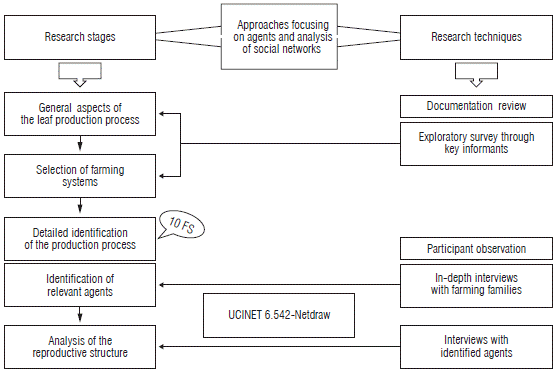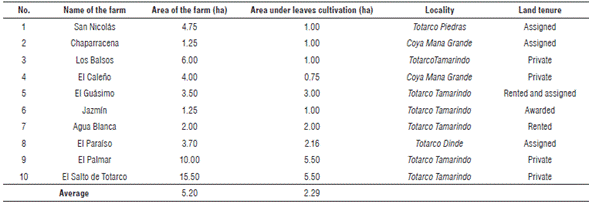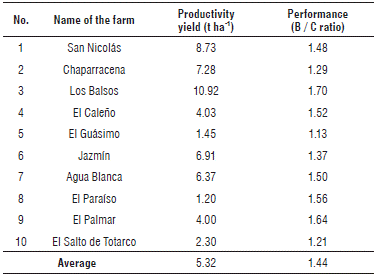Introduction
Colombian farmers have faced multiple adversities over a long history of violence that has been recently aggravated by the capitalist globalization policy imposed since the 1990s. The latter has promoted inequality and has accentuated rural poverty since it tends to favor small groups of rural entrepreneurs and marginalize the vast majority of smallholders (UNDP, 2011). The risk implied in these inequities is increased by excessive land concentration, forced displacement and problems associated to climate change, together with the rise of illicit crops and the lack of a strong and inclusive rural institutional framework (Garay, 2013). This has resulted in processes of de-peasantization (i.e., abandonment of the farming activity: Van der Ploeg, 2008), a social and economic phenomenon related to how the peasant population is excluded from their rural territories under the pressure of the economic policies that increasingly empower the business sector (Hocsman, 2015).
Faced with the risk of de-peasantization, rural societies resort to various adaptive resistance strategies related to both work modality and the intrinsic management of the productive units (Bendini and Steimbreger, 2010). In turn, this generates new configurations of the productive systems and their relation with the market.
When these resistance and adaptation strategies are used by a increasing number of farmers, a phenomenon known as re-peasantization takes place. The concept arose from rural sociology studies intended to explain the movement of farmers toward autonomous production models operating in closer association with the logic of peasant production. This has been done to re-structuring productive activities, reducing costs, optimizing ecological cycles and strengthening cooperation, together with the development of social and technological production innovations and short circuit marketing (Van der Ploeg, 2008).
What is common to many re-peasantization experiences is that they not only implement production modes based on proper traditional knowledge, but also seek for environmentally sustainable production and endogenous local development (Jenkins, 2000; Ray 1999). This particular farming knowledge constitutes an unexplored source of information that is in danger of being lost over the next generations (Knapp and Fernández-Giménez, 2009).
Traditional knowledge is considered as that acquired by experience and transmitted and adapted from generation to generation (Toledo and Barrera-Bassols, 2008). It is evident not only on adaptive production strategies, but also on skills, procedures and forms of organization and the relation with nature. In managing their productive systems, farmers organize and allocate natural, labor and economic resources under a particular prioritization logic that preserves their life conditions (Vélez, 2015). In the case of traditional farmers, subsistence is determined mostly by its relation to the environment (co-production) than by its linkage to markets (Toledo and Barrera-Bassols, 2008). In this prioritization, local knowledge is particularly relevant.
As result of its dynamic nature, traditional knowledge is enriched over time, resulting in innovations that contribute to increased production (Lápple et al., 2015). Innovations are considered as those human adaptations aimed to generate favorable socio-economic conditions for a given social group, or to solve particular needs (Rodima-Taylor et al., 2012). In the agricultural sector, innovators are farmers who have introduced changes in products or organizational processes, which are innovative to local or regional agriculture (Lápple et al.,,2015; Mileone, 2005). In the social field, innovation affairs refer to organizational strategies, ideas or arrangements relevant to the strengthening of local organizations and civic institutions, with the further goal to overcoming inequality and exclusion (Rodima-Taylor, 2012). Innovation itself is a mechanism on which society is constantly adapting to changes, which are determined, in turn, by people's social and cultural values (Chhetri et al., 2012).
The focus of the current study was the characterization and recognition of local adaptation and innovation strategies implemented by the 'Cachaco' plantain (Musa ABB S) leaves producers from the indigenous peasant communities of southern Tolima (Colombia), as a result of their local knowledge system. Local agents innovation, which has remained hidden to formal experts, is made visible in terms of its viability and social, economic and ecological relevance (Mileone, 2009; van der Ploeg, 2008). Since local innovation is presented as an expression of re-peasantization, its contribution and relevance to the design of local development strategies is analyzed.
Methodology
The study was carried out in the region of Los Totarcos, located in the upper basin of the Guaguarco River, which marks the geographical boundary between the municipalities of Coyaima and Natagaima (south of the department of Tolima, Colombia).The region corresponds to a Tropical Dry Forest life zone, with altitudes ranging from 450 to 700 m a.s.l. and average temperature of 28°C. In this territory, there are six Pijao native indigenous reservations (Totarco Niple, Totarco Tamarindo, Totarco Piedras, Totarco Dinde Tradicional,Totarco Dinde Independiente and Zanja Honda). The study analyzed 10 'Cachaco' leaves producing farms.
The study followed the approaches of agent-centered sociological analysis (Long, 2007) and social network analysis (Lugo-Morin, 2011). The former proposes to uncover local agents' knowledge about their natural, social and agricultural practices, assuming that they have the skills and capabilities to transform the environment (Gerritsen et al., 2009; Rivas and Quintero, 2014). It proposes a deeper understanding of local knowledge systems, thus addressing the inherent problems of agricultural research and extension processes and how to use local knowledge and technological change. On the other hand, the social networks approach allows the understanding of complex social phenomena originated from the interactions of observable local production systems with individuals, communities and institutions (Lugo-Morin, 2011). In addition, such dynamic not only facilitates the recognition of the processes of negotiation, cooperation and subordination that takes place within the formal relations held by local agents, but also reveals conflicts in a context of social interactions.
Fieldwork included an initial exploratory survey (Fig. 1) that allowed recording the antecedents of the studied productive innovation and to select farms dedicated to this activity along with the basin representative farming's of the region in leaf production. Used as an important research tool, participative observation allows the researcher to immerse into the farms in order to conduct in-depth interviews regarding the family livelihood.
The activities related to the production process were detailed and the relevant agents identified. Finally, an analysis of the 'Cachaco' leaves production network was performed in order to identify its configuration, allong with the basic characteristics of its interactions and their support among the most relevant agents.
The categories of analysis included technical aspects and gradients of plantain leves cultivation (production areas, inputs requirements, management and yields); economic analysis (costs, incomes and profitability); participation degree of the peasant family (addressing both basic and extended family networks and their participation on the productive activities); environmental analysis (crop structure) and social network analysis.
To identify the participation degree of the institutional agents on the cropping activity, interviews were conducted with the local leaders such as indigenous governors, local extension service technicians, institutional representatives and market intermediaries. Social network analysis was performed in UCINET 6.542 (Borgatti et al, 2002). The agents involved in the analysis of the networks included 10 farming systems; the social agents (10 main families and their respective extended relatives and their indigenous territories); the institutional agents ("Banco Agrario" and the extension, training and sanitary control services); the commercial agents (supply and labor providers, leaves wholesalers and production partners). The interactions between all these agents were represented through a graph in a "Net draw" software package.
Results and discussion
Characteristics of the farms and innovation under study
Considering that the Family Farm Unit (FFU) (administrative unit officially determined in the country as the area to generate the equivalent of two legal minimum salaries per department) size for Coyaima is 12 ha (Tab. 1), the studied plantain leaves productive farms can be considered to be small farmsteads, since only one of them exceeds this limit. Fifty percent of the families work in farms assigned by an indigenous reservation; 40% corresponds to owner farming families; and 10% work in rented lands. Only one farm combines the first and the last modalities.
These types of land tenure in the region show how the indigenous families participate in a reservation and how important is to have access to land and, therefore, labor means. In fact, almost all the families of the five reservations at the region have assigned a piece of land, which they use to plantain leaves production.
The distribution of the cultivated areas at the ten farms shows that the area grown with 'Cachaco' leaves, which averages 2.29 ha per farm, constitutes the main crop. The planted area oscillates between 0.75 ha and 5.50 ha.
Although the 'Cachaco' plantain crops were initially used to produce fruit, leaf production and trading started in the second half of the 1980s, when some local producers bought the crop leaves to trade them in Bogota. Since then, the producers processed younger leaves, which were slightly roasted in timber wood fire (a process known under the local Spanish term "soasar") and then folded and packed to satisfy the demand of the tamal packing industry (tamal is a traditional Colombian food). As the demand for plantain leaves increased, the farmers replaced their sugar cane plantations and established plantain leaves crops. Over time, they have progressively introduced technological changes to their farms regarding production, processing, packaging and marketing processes.
A key factor to this innovation was the "tamal tolimense" industry of Bogota, promoted by supermarkets and small rural entrepreneurs of the department of Tolima, who opened markets for this typical food in the capital of the city. This exemplifies how innovations generate novelties to the markets, which, in turn, strengthen such innovations (Lápple et al, 2015). The production of tamales has become a large industry of great economic impact for supermarkets and family small businesses, thus becoming one of the largest packed typical food industries of the country (Portafolio, 2012).
As a cultivar, 'Cachaco' plantain crops are known for their resistance to drought, which confers strong fitness to the climatic conditions of the tropical dry forest ecosystems of southern Tolima. The 'Cachaco' crop can maintain elevated leaves production for around 8 to 10 years. Nevertheless, it is frequent to find crops with 20 to 40 years of productive life. Production begins 8 months after planting the colino (local name given to the vegetative plantlet). To the third year onwards, leaves production allows cutting 6 to 8 leaves per site every 3 weeks, for a rough total number of leaves rolls ranging from 1800 to 2400 y-1 ha-1 (12.6 to 16.8 tons of leaf per year, with an estimated weight of 7 kg / roll). At the studied farms, yield averaged 5.32 t ha-1year-1 (Tab. 2), mainly due to planting density, labor dynamics and management modality.
At the 10 studied farms, an average benefit / cost ratio of 1.44 was calculated after considering monetary and non-monetary costs. This indicator was considered as positive in all cases (1.21 to 1.7). In the ordinary cost structure of the leaf production, the highest expense was represented by labor (94.38% of total costs), family labor accounting (78.53% of total costs) and hired labor force (15.85%).
A local innovation in the cultivation of 'Cachaco' plantain as a re-peasantization experience
The migration of a growing number of cassava and panela producers to 'Cachaco' plantain leaves cropping in the region of Los Totarcos caused a series of technological, social and economic changes in this territory. A significant increase of more than 600% in the cultivated areas took place along a 10-year period where the crop production was intensified, involving approximately 960 families in the studied region (Tab. 3). Thus, 'Cachaco' leaves production has become an important strategy for farming families to remain in the territory. As proposed by Bendini and Steimbreger (2010), new economic activities are likely to counterbalance de-peasantization processes and contribute to those of re-peasantization.
TABLE 3 Trajectory of the production of 'Cachaco' plantain leaves in the region of Los Totarcos.

Prepared by the authors based on data from the local Agricultural Census of the municipality of Coyaima (Tolima-Colombia). Municipality of Coyaima, 2015.
The emergence of the innovation analyzed in this study combines what Knapp and Fernández-Giménez (2009) denominate main categories of knowledge, named active knowledge applied to management decisions; knowledge that results from local dwelling; and integrative knowledge linking ecological, economic and social aspects.
Farmers who used to produce cassava starch and panela sugar cane in the upper basin of the Guaguarco river have migrated to the plantain leaves production as a new productive activity, which they have structured through their interaction with the local environment. As a result of their permanent adaptation to change, they were able to take advantage of the opportunity emerged with the plantain leaves production, which, based on their profound knowledge of their natural environment, triggered a new way of appropriating to the local markets (Toledo and Barrera-Bassols, 2008). This innovative way to interact with the environment (van der Ploeg, 1992; van der Ploeg, 2008), has given rise to both a regional product with specific cultural identity and a proper form of social development. This productive system emerges as a local innovation, made possible by the availability of genetic resources, on a specific ecosystem, occupied by a particular cultural group (anthropic biome) and driven by a specialized market demand (Figure 2).
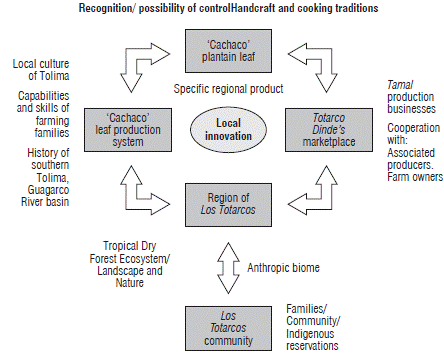
FIGURE 2 Integral appropriation of the territory for the production of 'Cachaco' plantain leaves in the region of Los Totarcos. Modified by the authors from Gerritsen et al., 2009.
From an ecological standpoint, the positive effects of this productive activity arise from the crop structure, the length of its lifecycle and its agronomic management. As an herbaceous plant with a semi-permanent cycle, 'Cachaco' plantain has the additional capability of storing moisture in its tissues, thus resisting drought conditions and preventing over-tillage of the soil, which certainly preserves its characteristics. Additionally, and due to the plant architecture, there is a low risk of soil erosion; the plat provides an adequate coverage to heavy rain effects.
In turn, the widespread association with forest species like Iguá (Pseudosamanea guachapele), Caracoli (Anacardium excelsum) and Palma Real (Attalea butyracea) increase the environmental benefits such as the enhancing of microclimate conditions, pests and diseases protection by biological controllers, symbiotic relationships (nitrogen fixation (e.g., Iguá) and the permanence of other beneficial organisms), and the conservation of associated wild species, among others.
Productivity can be significantly increased through local innovations. An example presented by Lápple et al. (2015) emphasizes how innovations can result after applying single or multiple changes to lead the introduction of new components into the productive processes in the farm. Three elements of technological innovation can be mentioned as most relevant in the agricultural system of 'Cachaco' plantain: genetic material, weed management and packing mode.
From a genetic standpoint, the importance of the 'Cachaco' plantain material lies on its unique fitness to the climatic and soil conditions of the area, which were detected by local farmers through observation and interaction with their resources (genetic material, soil, climate and information). The use of herbicides to weed control was a technological adaptation intended to optimize some labor force to the harvest and postharvest activities. The packing system amendment, which went from a leaf stacking to a leaf rolling , due to the difficulties brought by the former system to both leaf and tamal producers, since the heavy weight of the packages used to complete handling and transportation. In addition, including the leaf vein on the final product was inconvenient to the farmers, since it is an important source of organic matter for the crop.
As far as the market circuits are concerned, plantain leaf producers travel variable distances from the farms to the local marketplace, using beasts of burden along brida lpaths, which turns the product transport into a very heavy labor. The distance between Totarco Dinde's market place, where the totality of the 'Cachaco' leaves are sold to wholesalers, and Paloquemao market place in Bogota, where it is distributed, does not exceed 220 km. The distances to alternative market places like those found in the cities of Ibagué and Neiva are located to 138 and 111 kilometers, respectively. Thus, the geographic location of Los Totarcos represents a great opportunity to the projection of the plantain leaf market to other places of the country.
According to the network analysis graph (Figure 3), the family units represents the main social agent sustaining the crop. The structure of the families shows that, in average, they have 7.2 members, out of which 3.2 are adults, which shows an elevated percentage of children. From all family members, 91.7% live in the farms; 87.5% of the adults are fully involved on the leaf production, while 33.7% of the children are just partially involved.
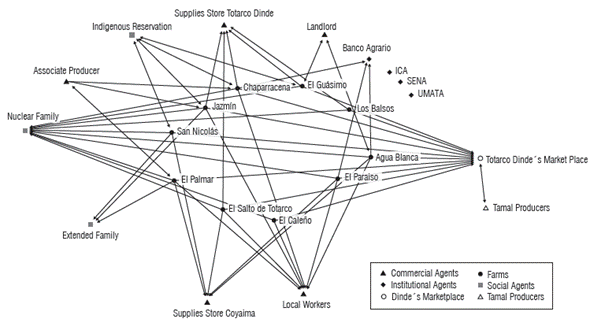
FIGURE 3 Graph illustrating the agents linked to the production of 'Cachaco' leaf in the region of Los Totarcos.
These figures not only which are the family terms to remain in the region, but also their dynamic articulation to leaf production through its various activities, namely cropping, harvest and postharvest, which enable the integration of all the family members.
In the present case, the farmer's adaptability has allowed the emergence of a productive innovation featured by technological and social specificities. In other words, the way this innovation transforms and uses the landscape in its favor has allowed not only the generation of a genuine productive activity that improves the local economy, but certain social conditions that generate well-being to the community. There is a close relationship between agricultural innovation and social capital. According to Van Rijn et al. (2012), the adoption degrees of productive innovations are related directly to strong and stable social structures. In the region of Los Totarcos these structures, which correspond to indigenous families, communities and indigenous reservations, have generated the particular form of production that is reported in the present work.
The social aspect of the 'Cachaco' plantain leaves innovation focuses on the nuclear farming family, since all its members are able to participate in the production, harvest, post-harvest, transport and packaging activities. In this way, each family member acquires specific practical skills within the whole process.
Children and youngsters are related to the cropping activity. From the age of 15 to 17, they independently assume the harvest and post harvest activities, receiving the same payment as an adult worker. Just as well, they can receive from their parents a piece of land to grow their own plot of 'Cachaco' and benefit from it autonomously. In this way, leaf production facilitates not only the articulation and strengthening of the family network, but also the retention of strong labor force in the territory.
The farm systems also show strong relations of dependence with the Totarco Dinde marketplace, where all the leaf production is sold. The relations held by the farmers with credit (the Banco Agrario), training (SENA), rural extension (UMATA), and sanitary control (ICA) institutions were analyzed. At present, only the bank is intervening in this local innovation, since they encourage small-scale productive projects for which they offer credits with special interests and repayment plans. No other institution offers any kind of service in the socio-technical network, as these innovations are kept hidden by the expert knowledge system, which are centrally affected by formal bureaucracy.
Van der Ploeg et al. (2012) suggest that rural development can be analyzed from market dynamics. In the case of the plantain leaf market, the most important commercial agents are the providers of supplies and services, along to the buyers and associate producers. The buyers, who are either leaves wholesalers or tamal producers, purchase the product in the regional marketplace of Totarco Dinde, which is specialized in 'Cachaco' leaves and is considered to be the biggest one regarding this specific product. Although other regions of Tolima such as El Guamo, Saldaña and Purificación also produce and trade plantain leaves, the largest number of farmers is in the region of Los Totarcos (Coyaima). It was precisely in the locality of Totarco Dinde where the homonymous marketplace was established in 1997.
As politically autonomous entities, the indigenous reservations do not interfere on the regulation of the plantain leaf production processes. Nonetheless, they are fundamentally important to the governance of the territory, since they can affect leaf production, environmental protection and sanitary management regulations.
Although several studies suggest that productive innovations necessarily involve extension services and technical assistance (Knapp and Fernández-Giménez, 2009; Chhetri et al., 2012), the case of 'Cachaco' plantain leaves demonstrates innovation emerged from the community itself. Similar cases of innovation arising from local knowledge systems have been demonstrated on shrimp production in Bangladesh (Chowdhury and Khairun, 2014), traditional horticulture in the Argentine Patagonia (Eyssartier et al., 2013) and cereals in Tunisia (Dolinska and Aquino, 2016).
The importance of this local innovation in the configuration of Rural Development programs aimed to territorial sustainability
The modernization paradigm that currently dominates Rural Development theory and practice is currently being challenged by new paradigms (Van der Ploeg et al., 2000; Wilson, 2009; Morgan, 2010). The Territorial Development approach (Schejtman and Berdegué, 2003), which corresponds to the formal logic of the institutional mega-projects, follows only the economic interest of integration into globalized markets. As such, it reproduces the logic of mass consumption goods, without integrating any biophysical or socio-cultural aspects (Ramírez-Miranda, 2014; Schneider, 2006).
Such complexity highlights the fact that rural development is not adding new things to old situations. Territorial rural development should not be conceived only as a result of the laws of political economics, the logic of commercialization, and patterns of capital accumulation. Instead, it is the result of complex interactions among diverse circumstances in particular territories. The rural territorial development must therefore be an ethical and political project strengthened by the action and involvement of the affected social agents and the organizations of society in general. As such, it should be featured not only by multi-level, multi-agent and multifaceted approaches inscribed on the traditional modes of integrating nature and society, but also by a thorough revaluation of agricultural practices and a diversity of other rural activities (Fajardo, 2012; Schneider, 2006; Van der Ploeg et al., 2000).
In this ideological context, which stands for a postmodern rural development approach, the concept of re-peasantization (with its many expressions) has been catalogued by Van der Ploeg (2008) as one of the three main trends of contemporary agriculture world-wide. Re-peasantization means giving a new role to farmers and their families in the structuring of rural development territorial initiatives. It implies that farmers are valued for their experiences, knowledge and ideas about local rural problems, such as productivity improvement, conservation of the natural resource base, linkage to markets, and many other aspects of rural life. Re-peasantization, which closely resonates with approaches such as multi-functionality, is achieved through diversification strategies aimed at developing a closer co-production relationship with nature (Rentig et al., 2009; Van der Ploeg et al., 2000).
The local innovation of 'Cachaco' production represents a process of re-peasantization that has allowed the farmers to reconfigure their production means, generating new market alternatives with important socio-environmental effects to their ancestral territories. This experience leads us to reflect on the need to flexibilize the expert-designed system of technical and scientific knowledge, and consider the deviations and unexpected results obtained by the communities. This implies valuing the local innovations implicit in traditional agricultural systems, thus entering dialogue with conventional agrarian sciences and improving both traditional and modern agroecosystems (Van der Ploeg, 2008). The traditional knowledge incorporation into our current understanding of the agricultural technology would allow the design of rural development programs that are capable of both transcending the technology transfer model and implementing social knowledge management systems based on local interaction networks. Such processes of revaluation and inclusion will not only allow a better understanding of the reality of national agriculture, but also strengthen a continuous process of traditional knowledge transfer through the agricultural extension services of rural development programs.
Conclusions
The production of 'Cachaco' plantain leaves is important in the region of Los Totarcos in terms of how farming families are related to territory appropriation and the production process itself, thus resulting in an important economic base for the region. This activity, which constitutes a particularly productive, economic, social and environmental innovation generated from the farmers rationality, was made possible by the development of creative work processes emerged in the relationship established by the farmers with their natural and socio-cultural environment.
As a local productive innovation, 'Cachaco' leaves have enabled communities in the region to strengthen their social fabric, providing the new generations with an alternative to remain in the territory. The re-peasantization experience has improved life quality, created a cultural territory with genuine characteristics, and contributed to strengthening endogenous rural development processes and, therefore, to regional sustainability.
The institutional recognition of this regional production process and its inclusion in Territorial Rural Development programs is particularly promising. In effect it is likely to constitute an alternative not only to improve life conditions of hundreds of indigenous and peasant families living in this territory, but also for creating better governance opportunities for them, thus strengthening the identity of an indigenous group that is in risk of disappearing.
New horizons to advance in this research include the study and recognition of the rationality of traditional farmers and their own knowledge, to adapt the agriculture models to their particular conditions; the role of re-peasantization in the structuring of territorial initiatives of rural development and the importance of implementing local knowledge management systems based on networks of social interaction. These aspects will be relevant for inclusion in participatory rural extension programs.













